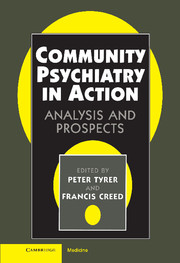Book contents
- Frontmatter
- Contents
- List of contributors
- 1 Essential issues in community psychiatry
- 2 Evaluation of community treatments for acute psychiatric illness
- 3 Synopsis of the Daily Living Programme for the seriously mentally ill: a controlled comparison of home and hospital based care
- 4 Evaluation of a complete community service
- 5 Early intervention study of psychiatric emergencies
- 6 Evaluation of psychiatric services: the merits of regular review
- 7 A home based assessment study
- 8 Home treatment as an alternative to acute psychiatric inpatient admission: a discussion
- 9 The toxicity of community care
- 10 Community mental health services: towards an understanding of cost-effectiveness
- 11 Future research strategies
- Index
9 - The toxicity of community care
Published online by Cambridge University Press: 06 July 2010
- Frontmatter
- Contents
- List of contributors
- 1 Essential issues in community psychiatry
- 2 Evaluation of community treatments for acute psychiatric illness
- 3 Synopsis of the Daily Living Programme for the seriously mentally ill: a controlled comparison of home and hospital based care
- 4 Evaluation of a complete community service
- 5 Early intervention study of psychiatric emergencies
- 6 Evaluation of psychiatric services: the merits of regular review
- 7 A home based assessment study
- 8 Home treatment as an alternative to acute psychiatric inpatient admission: a discussion
- 9 The toxicity of community care
- 10 Community mental health services: towards an understanding of cost-effectiveness
- 11 Future research strategies
- Index
Summary
Introduction
This chapter is based, in part, on the overview of the studies (Chapter 1) and may will repeat some of the points made in Chapter 8 by Frank Holloway but perhaps in more detail. It will also focus on the possibility of generalising from these studies and whether the results can be sustained over time.
The run down of hospital based care was predicated on the positive effects for patients. In the community there are increased chances for continuing and practising skills as well as opportunities for widening patients’ social networks. The process of case management offered in the community is also thought to encourage patients to take their medication and thus reduce levels of positive symptoms. The results of the experimental studies of novel community services discussed in this seminar, however, have all been disappointing.
Although I am not a ‘product champion’, I am one of the evangelists for community based treatments so you will understand how disappointed I am in the results. There have been no consistent positive findings except perhaps for greater user satisfaction with the services. Given that all the studies involved a committed, if not zealous, group of staff with reasonable resources these results put together are surprising. I would like you to bear in mind that I am a supporter of community care but I am nevertheless going to criticise the studies.
Why such poor results? The first step of any researcher who comes up with results contrary to expectations is to look at the design of the studies. Are there any features which would militate against finding positive results?
- Type
- Chapter
- Information
- Community Psychiatry in ActionAnalysis and Prospects, pp. 97 - 110Publisher: Cambridge University PressPrint publication year: 1995
- 2
- Cited by



